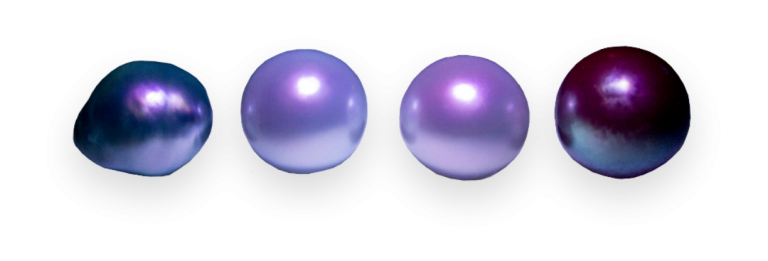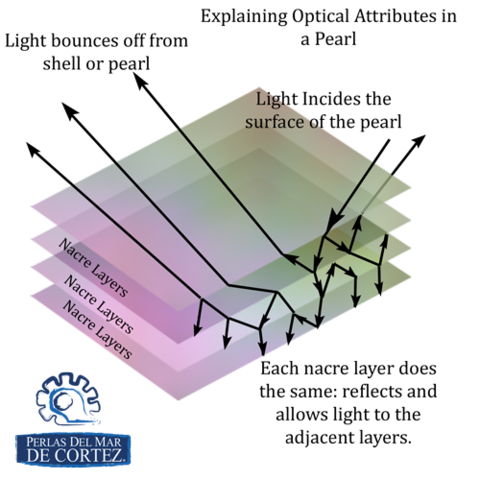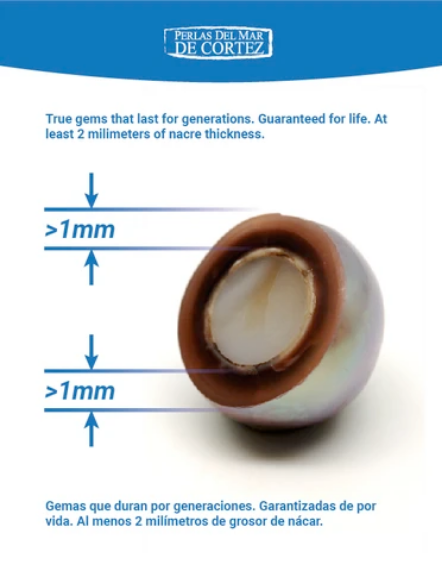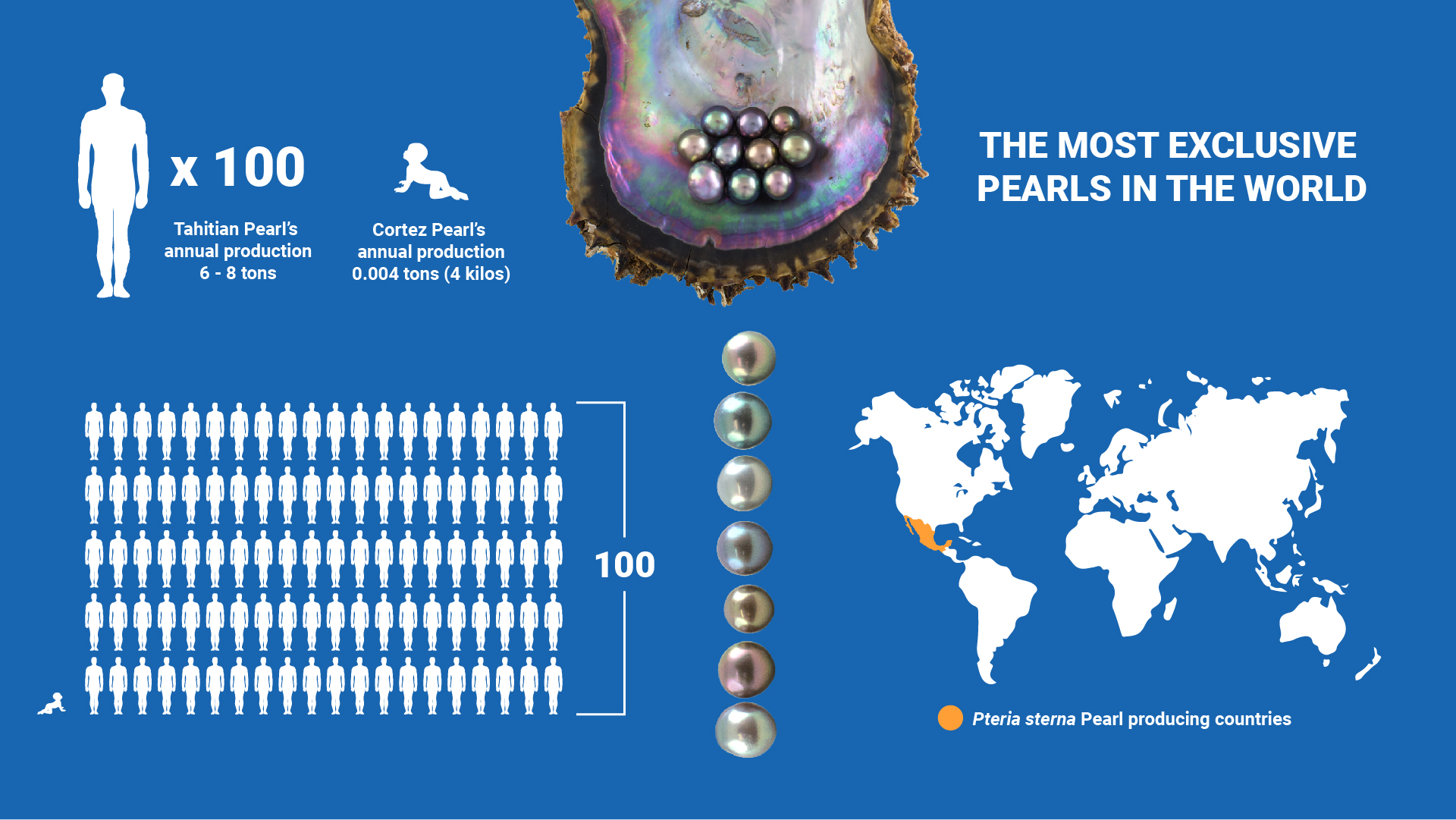Value of a Pearl

Color

Orient

Luster

Surface

Size

Shape
There are many attributes that should be taken into consideration in order to assign a value to an individual pearl. We will talk about these and give you the information you require in order to make a good selection.

Luster

Shape

Skin Purity
Surface Defects

Size

Orient
Overtones

Gems are distinguished by three aspects:
Beauty, Rarity, and Durability. The Beauty of these pearls comes with extraordinary colors and a soft velvety luster, the Durability is given by a good thickness of mother-of-pearl thanks to the long cultivation time, and the Rarity, which is essential for gems, has it due to the difficult and laborious that it is to obtain these pearls of our species Pteria sterna.
Here is a brief explanation of
each of these factors:
1) LUSTER:
This is an attribute you should take seriously into consideration when purchasing a pearl. A pearl’s luster is the warm, silky, glow of the pearl. But do not confuse luster with “shine”. A polished piece of steel is very shinny, but it is not lustrous.
Of course, the higher the luster of the pearl, the more valuable it becomes.
Of course, the higher the luster of the pearl, the more valuable it becomes.
2) SHAPE:
Truly 100% round shaped pearls are much more difficult to obtain, thus they command a much higher prize. Only from 5 to 25% of a pearl harvest come out round to semi-round in shape.
So, a round shape takes first place in value, followed by “off-round” (about 2-5% of the pearl’s shape is not-round), semi-baroque (symmetrical shapes: drops, buttons, ovals) and finally baroques (asymmetrical pearls).
So, a round shape takes first place in value, followed by “off-round” (about 2-5% of the pearl’s shape is not-round), semi-baroque (symmetrical shapes: drops, buttons, ovals) and finally baroques (asymmetrical pearls).
Semi baroque pearls are highly coveted in some countries, especially in the drop shapes, where they are known as “cabochons”, “teardrops” or “pears”. They are very popular in drop-style jewelry and used mainly in pendants and earrings.
Baroque pearls do not have a definitive shape, being always irregular in their skin/surface, coloring and appearance. Baroque pearls are very unique, so they can give a more natural look to jewelry.
So, as you can see, many pearl shapes exist, but people tend to identify a pearl as being “round”. This is due to the fact that the Japanese were the World’s leading suppliers of cultured pearls (today, the main producer of pearls is China), and they are able to produce many round pearls thanks to:
Baroque pearls do not have a definitive shape, being always irregular in their skin/surface, coloring and appearance. Baroque pearls are very unique, so they can give a more natural look to jewelry.
So, as you can see, many pearl shapes exist, but people tend to identify a pearl as being “round”. This is due to the fact that the Japanese were the World’s leading suppliers of cultured pearls (today, the main producer of pearls is China), and they are able to produce many round pearls thanks to:
- The fact that they have a very high production of cultured pearls: around 20 metric tons of Akoya pearls per year, thus they have a higher chance at obtaining more rounds.
- They have very good seeding technicians: and these play an important role in pearl quality.
- They grow their cultured pearls from 4 to 8 months only: this does not allow their pearls to “deviate” from the nuclei’s round shape.
3) SKIN PURITY/ SURFACE DEFECTS
This attribute is also known as the “Cleanliness” of the pearl. As it can be expected: the lesser the number of imperfections on the surface of the pearl, the higher its value.
Cortez Pearls are only available in the following grades:
- Gem
- A and
- B
It is fairly common for a pearl to have surface defects. After all, a pearl is a living creation, not a cold hard stone dug from the Earth. One should allow for defects in a pearl, just as we allow leather goods to have skin markings, without which they would look just like plastic.
Some common surface defects:
a. Missing Nacre:
This defect resembles an “animal bite” on many occasions. It is caused by a secretory problem in the mantle (patches of cells within the pearl sac become abnormal and cannot secrete nacre, or will produce calcite instead). If this defect appears on a large proportion (over 30%) of the pearl, it should be considered a reject.
This defect resembles an “animal bite” on many occasions. It is caused by a secretory problem in the mantle (patches of cells within the pearl sac become abnormal and cannot secrete nacre, or will produce calcite instead). If this defect appears on a large proportion (over 30%) of the pearl, it should be considered a reject.
b. Spots/Protein Deposition:
These spots appear when there are secretory problems in the mantle (patches of cells within the pearl sac become abnormal and cannot secrete nacre, and will produce protein instead). These “spots” not only make the pearl look less appealing, but they may also indicate other structural problems…try to avoid these pearls.
c. Waves/Undulations:
Some people do not consider these to be a problem or defect, but consider them more like a natural pattern, as seen on many baroque pearls. Anyway, since the surface of the pearl appears to be disjoined (surface reflection or luster is diminished), the value of the pearl is lessened.
d. Other Defects
Cracks, peel-offs and deep bruises (mechanical scars) are not considered to be natural flaws. These are serious defects that turn pearls into junk. A pearl with a crack (or even a fissure) is damaged to a point where it will break apart. Pearls that loose some of their covering (usually, this only happens to thinly covered cultured pearls) will crack and expose their nucleus.
These spots appear when there are secretory problems in the mantle (patches of cells within the pearl sac become abnormal and cannot secrete nacre, and will produce protein instead). These “spots” not only make the pearl look less appealing, but they may also indicate other structural problems…try to avoid these pearls.
c. Waves/Undulations:
Some people do not consider these to be a problem or defect, but consider them more like a natural pattern, as seen on many baroque pearls. Anyway, since the surface of the pearl appears to be disjoined (surface reflection or luster is diminished), the value of the pearl is lessened.
d. Other Defects
Cracks, peel-offs and deep bruises (mechanical scars) are not considered to be natural flaws. These are serious defects that turn pearls into junk. A pearl with a crack (or even a fissure) is damaged to a point where it will break apart. Pearls that loose some of their covering (usually, this only happens to thinly covered cultured pearls) will crack and expose their nucleus.
4) SIZE:
As In the case of many other gemstone: the bigger its size is, the greater its value. Depending on the type of jewelry you plan to use, small pearls are more adequate than large ones for -let’s say- rings and studs.
Larger sizes are less abundant so they are able to command a much better price. Once a pearl attains a size of 10 mm it can command a higher price, but there are other breakpoints as well: 12, 14, 18 and 20 mm. This means that the price of a pearl may as well double from the size previous to that break point.
Chose the size of the pearl depending on your needs and budget. When looking for a 10 mm pearl, selecting a 9.9 mm pearl is a great choice because you do not pay the increase in price and yet it looks basically the same.
Larger sizes are less abundant so they are able to command a much better price. Once a pearl attains a size of 10 mm it can command a higher price, but there are other breakpoints as well: 12, 14, 18 and 20 mm. This means that the price of a pearl may as well double from the size previous to that break point.
Chose the size of the pearl depending on your needs and budget. When looking for a 10 mm pearl, selecting a 9.9 mm pearl is a great choice because you do not pay the increase in price and yet it looks basically the same.
5) ORIENT/OVERTONES:
This is one of the most beautiful effects found on a pearl, and the hardest one to explain or describe. This effect is given -in part- by the pearl’s nacre thickness, its spiraled surface and the quality of its nacreous (Aragonite) crystals.
This visual effect is seen as a series of concentric rings of deepening color. Sometimes it looks like a “halo” surrounding the outer diameter of the pearl. A pearl with such an effect will never be mistaken as a fake-pearl nor as a freshwater pearl, and it is highly coveted.
The word “orient” is attached to this effect in lieu of a centuries old fact. To the Romans -who loved these Gems- pearls came from two different sources: freshwater pearls (harvested from European rivers and lakes) and “Oriental Pearls” that were imported from the Middle-East (the “Orient” for Romans). To the Romans, “Oriental Pearls” came mostly from the Persian Gulf and sometimes even from Asian countries…and those were mostly saltwater pearls.
This visual effect is seen as a series of concentric rings of deepening color. Sometimes it looks like a “halo” surrounding the outer diameter of the pearl. A pearl with such an effect will never be mistaken as a fake-pearl nor as a freshwater pearl, and it is highly coveted.
The word “orient” is attached to this effect in lieu of a centuries old fact. To the Romans -who loved these Gems- pearls came from two different sources: freshwater pearls (harvested from European rivers and lakes) and “Oriental Pearls” that were imported from the Middle-East (the “Orient” for Romans). To the Romans, “Oriental Pearls” came mostly from the Persian Gulf and sometimes even from Asian countries…and those were mostly saltwater pearls.

Muy importante además, es la durabilidad de la perla en sí. Una buena capa de nácar le asegura una larga vida a la perla (más de 500 años), mientras que un grosor menor a 0.3 mm asegura una vida de tan sólo unos cuantos meses.

El nácar además de ser el material del que están hechas las perlas, se puede utilizar para hacer la crema de concha nácar que se utiliza para quitar manchas en la piel ocasionadas por el sol, acné o edad.

Para aprender y desarrollar experiencia en la valuación de Perlas y otras Gemas en México, visita el sitio del Instituto de Gemología y Alta Relojería.





